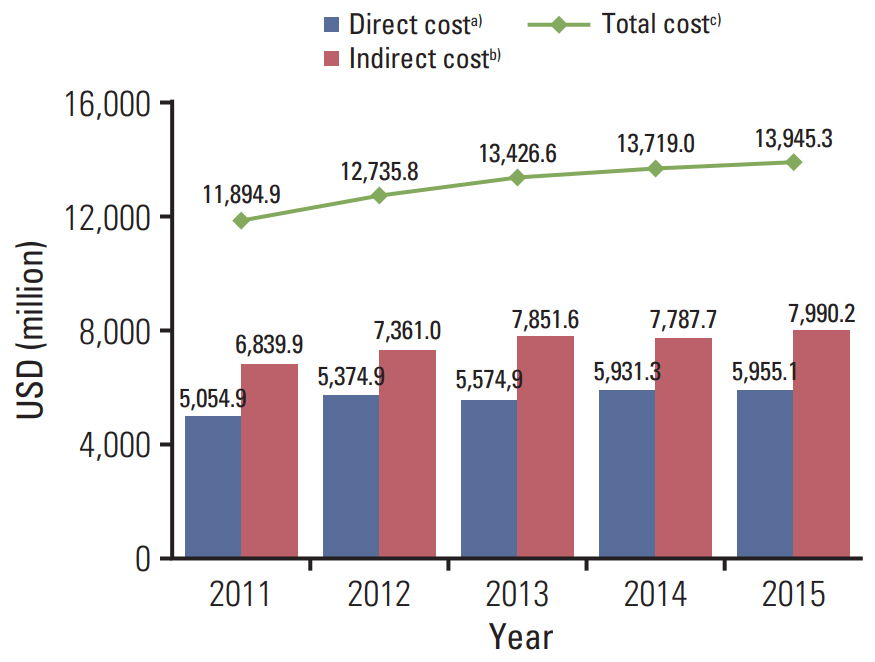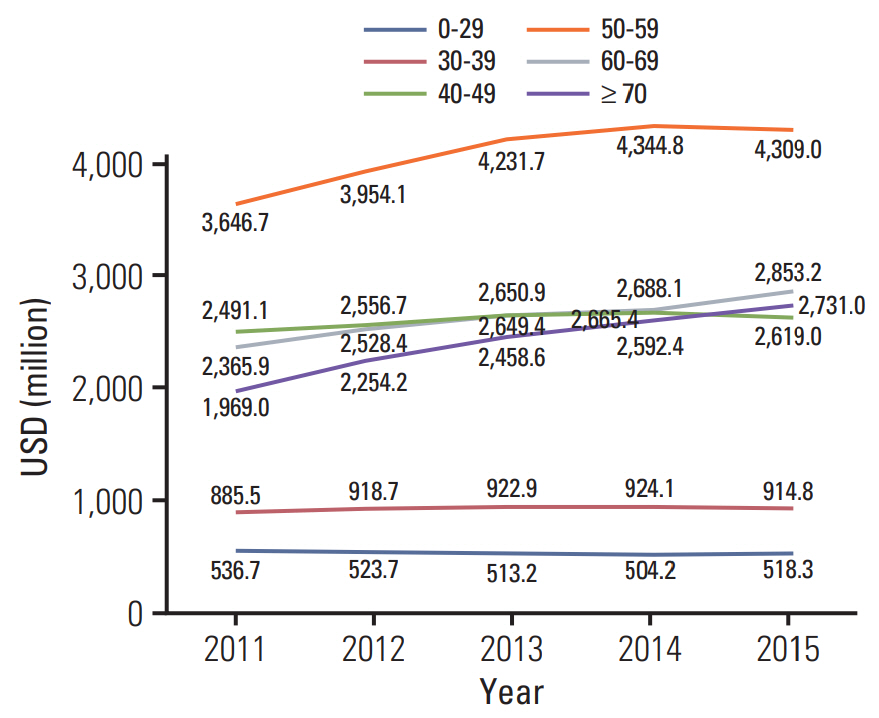Cancer Res Treat.
2020 Jul;52(3):896-906. 10.4143/crt.2019.398.
Socioeconomic Burden of Cancer in Korea from 2011 to 2015
- Affiliations
-
- 1Division of Cancer Control and Policy, National Cancer Control Institute, National Cancer Center, Goyang, Koreayang, Korea
- 2Department of Preventive Medicine, Kyung Hee University College of Medicine, Seoul, Korea
- 3Department of Preventive Medicine, Korea University College of Medicine, Seoul, Korea
- 4Department of Cancer Control and Population Health, National Cancer Center Graduate School of Cancer Science and Policy, National Cancer Center, Goyang, Korea
- KMID: 2504468
- DOI: http://doi.org/10.4143/crt.2019.398
Abstract
- Purpose
Though the socioeconomic burden of cancer on patients is increasing in South Korea, there is little research regarding the type of cancer that incurs the highest costs. This study analyzed the socioeconomic burden on cancer patients from 2011 to 2015 according to sex and age.
Materials and Methods
A prevalence-based approach was applied utilizing claim data of the National Health Insurance Service in Korea to estimate the socioeconomic burden of cancer on patients. Patients who received treatment for cancer from 2011 to 2015 were the study subjects. The total socioeconomic burden of their disease and treatment was divided into direct and indirect costs.
Results
There was an increase of 50.7% for 5 years, from 821,525 to 1,237,739 cancer patients. The cancer costs for men and women increased $8,268.4 million to $9,469.7 million and $3,626.5 million to $4,475.6 million, respectively. Furthermore, the 50-59-year-old age group accounted for a large portion of the total disease cost. Liver, lung, stomach, and colorectal cancers created the heaviest economic burdens on patients.
Conclusion
Overall, this study indicates new policies for cancer prevention, early detection, and postcancer treatment management are necessary to help limit the costs associatedwith cancer, especially in the elderly, and provides a foundation for establishing cancer-related health care policies, particularly by defining those cancers with heavier disease burdens.
Figure
Cited by 3 articles
-
Validation of Cancer Diagnosis Based on the National Health Insurance Service Database versus the National Cancer Registry Database in Korea
Min Soo Yang, Minae Park, Joung Hwan Back, Gyeong Hyeon Lee, Ji Hye Shin, Kyuwoong Kim, Hwa Jeong Seo, Young Ae Kim
Cancer Res Treat. 2022;54(2):352-361. doi: 10.4143/crt.2021.044.Trend Analysis and Prediction of Hepatobiliary Pancreatic Cancer Incidence and Mortality in Korea
Hyeong Min Park, Young-Joo Won, Mee Joo Kang, Sang-Jae Park, Sun-Whe Kim, Kyu-Won Jung, Sung-Sik Han
J Korean Med Sci. 2022;37(28):e216. doi: 10.3346/jkms.2022.37.e216.2022 KLCA-NCC Korea practice guidelines for the management of hepatocellular carcinoma
J Liver Cancer. 2023;23(1):1-120. doi: 10.17998/jlc.2022.11.07.
Reference
-
References
1. Bray F, Ferlay J, Soerjomataram I, Siegel RL, Torre LA, Jemal A. Global cancer statistics 2018: GLOBOCAN estimates of incidence and mortality worldwide for 36 cancers in 185 countries. CA Cancer J Clin. 2018; 68:394–424.
Article2. National Cancer Center. Press release for 2016 cancer statistics [Internet]. Goyang: National Cancer Center;2019. [cited 2019 Dec 10]. Available from: https://ncc.re.kr/cancerStatsView.ncc?bbsnum=459&searchKey=total&searchValue=&pageNum=1 .3. Statistics Korea. 2017 Statistics of causes of death. Daejeon: Statistics Korea;2018.4. Statistics Korea. 2017 Population and housing census. Daejeon: Statistics Korea;2018.5. Yancik R. Population aging and cancer: a cross-national concern. Cancer J. 2005; 11:437–41.6. Byun JY, Yoon SJ, Oh IH, Kim YA, Seo HY, Lee YH. Economic burden of colorectal cancer in Korea. J Prev Med Public Health. 2014; 47:84–93.
Article7. Yabroff KR, Lund J, Kepka D, Mariotto A. Economic burden of cancer in the United States: estimates, projections, and future research. Cancer Epidemiol Biomarkers Prev. 2011; 20:2006–14.
Article8. Kim SG, Hahm MI, Choi KS, Seung NY, Shin HR, Park EC. The economic burden of cancer in Korea in 2002. Eur J Cancer Care (Engl). 2008; 17:136–44.
Article9. Kim J, Hahm MI, Park EC, Park JH, Park JH, Kim SE, et al. Economic burden of cancer in South Korea for the year 2005. J Prev Med Public Health. 2009; 42:190–8.
Article10. Lee KS, Chang HS, Lee SM, Park EC. Economic burden of cancer in Korea during 2000-2010. Cancer Res Treat. 2015; 47:387–98.
Article11. National Center for Health Statistics. Healthy people 2000 review, 1995-96. Hyattsville, MD: Public Health Services;1996.12. Murray CJ, Lopez AD. Global mortality, disability, and the contribution of risk factors: Global Burden of Disease Study. Lancet. 1997; 349:1436–42.
Article13. Baily MN, Garber AM, Berndt ER, Cutler DM. Health care productivity. Brookings Pap Econ Act. Microeconomics. 1997; 1997:143–215.14. Institute of Medicine. Scientific opportunities and public needs: improving priority setting and public input at the National Institutes of Health. Washington, DC: The National Academies Press;1998.15. Public Health Agency of Canada. The economic burden of illness in Canada, 2010. Ottawa, ON: Public Health Agency of Canada;2017.16. Vos T, Goss J, Begg S, Mann N. Projection of health care expenditure by disease: a case study from Australia. New York: United Nations;2007.17. National Cancer Center. Annual report of cancer statistics in Korea in 2015. Goyang: National Cancer Center;2017.18. Health Insurance Policy Research Institute. Survey on the benefit coverage rate of National Health Insurance in 2011~2015. Wonju: National Health Insurance Service;2012-2016.19. Korea Health Panel Survey [Internet]. Sejong: Korea Institute for Health and Social Affair;2019. [cited 2019 Mar 7]. Available from: http://www.khp.re.kr/eng/main.do.20. Kim YA, Oh IH, Yoon SJ, Kim HJ, Seo HY, Kim EJ, et al. The economic burden of breast cancer in Korea from 2007-2010. Cancer Res Treat. 2015; 47:583–90.
Article21. Korean Statistical Information Service. International statistical exchange rate in 2015. Daejeon: Korean Statistical Information Service;2019.22. Bray F, Jemal A, Grey N, Ferlay J, Forman D. Global cancer transitions according to the Human Development Index (2008-2030): a population-based study. Lancet Oncol. 2012; 13:790–801.
Article23. United Nations. World population ageing 2017: highlights. New York: United Nations;2017.24. Gong YH, Jo MW. Cost estimation of productivity loss of elderly over 70 due to premature mortality reflecting elderly employment in an aged society. J Health Tech Assess. 2017; 5:89–94.25. Kim J, Noh JW, Park J, Huh T, Kwon YD. Association between health-related quality of life and work status in older Korean adults. Geriatr Gerontol Int. 2018; 18:1629–33.
Article26. Brown ML, Lipscomb J, Snyder C. The burden of illness of cancer: economic cost and quality of life. Annu Rev Public Health. 2001; 22:91–113.
Article27. van den Hout WB. The value of productivity: human-capital versus friction-cost method. Ann Rheum Dis. 2010; 69 Suppl 1:i89–91.
Article28. Pritchard C, Sculpher M. Productivity costs: principles and practice in economic evaluation. London: Office of Health Economics (OHE);2000.29. Jung YH, Ko SJ. Estimating socioeconomic costs of five major diseases. Korean J Public Finance. 2004; 18:77–104.30. Cho GJ. Clinical research using medical big data. Anesth Pain Med. 2017; 12:9–14.
Article
- Full Text Links
- Actions
-
Cited
- CITED
-
- Close
- Share
- Similar articles
-
- Measuring Trends in the Socioeconomic Burden of Disease in Korea, 2007-2015
- The role of neoadjuvant chemotherapy in ovarian cancer patients with extensive tumor burden
- The Economic Burden of Breast Cancer in Korea from 2007-2010
- The Socioeconomic Burden of Acquired Brain Injury among the Korean Patients over 20 Years of Age in 2015–2017: a Prevalence-Based Approach
- Sleep Disorder and Socioeconomic Burden



